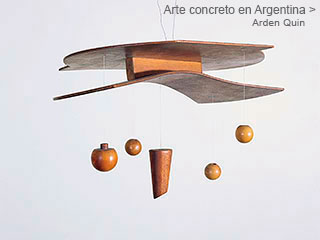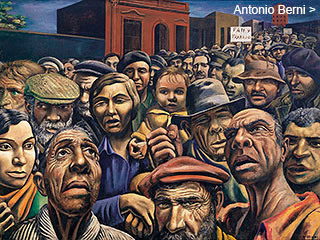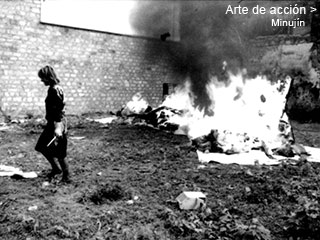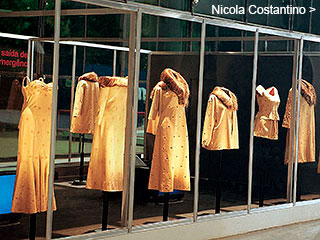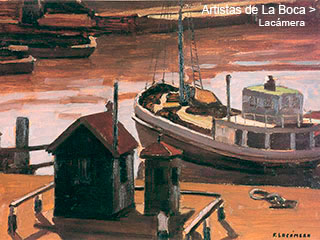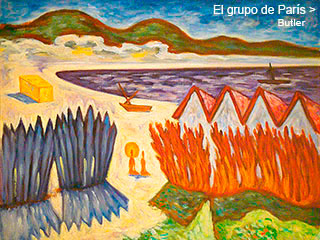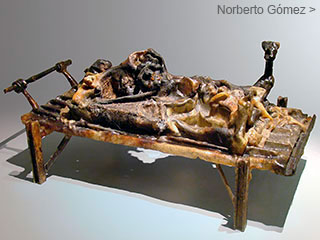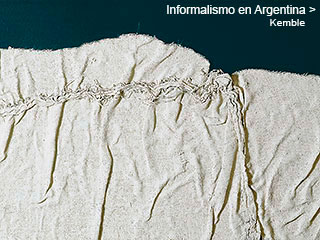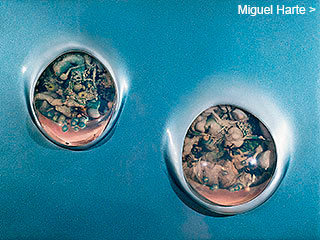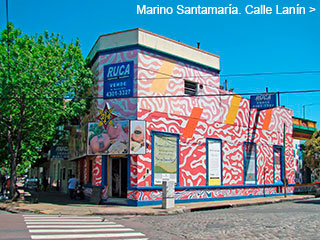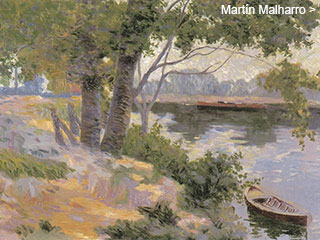Menú
Algunos dossiers
La Boca
Artists
Artists
by
Florencia Battiti and Cintia Mezza
August 2006
August 2006
We are about to venture into the fascinating world of the famed La Boca artists. This dossier reviews the gravitations of the modernization process of Argentine art throughout the last one hundred years, and the role that its growing cultural institutions played along the way. This investigative work has been authored by Florencia Battiti, and assisted by Cintia Mezza.
The tango in La Boca of the Riachuelo
La Boca neighborhood, to this day, is a typical and particular suburb, and a must for tourists to visit. Nevertheless, towards the end of the XIX century, cornered against the river, it was an “arrabal” (a tough neighborhood) inhabited by Italians, especially from Geneva, Creoles, Spanish, Negroes and farmers. The black population of La Boca was at its height towards 1850 in a new sector of the suburb, on cammin vegio (old trail) near the Piojo stream. From the center of this small world and its heterogeneous content, will flourish some of the distinctive characteristics of what would later become the tango.
Controversial from its origins, as early as 1889, the normative of the language defined it as a “party and dance of the Negroes and of the people of Latin America”. One hundred years had to go by for the dictionary to define tango as an “Argentine dance, now internationally known, where both partners move in an embraced form, to the musical rhythm of a two by four compass”.
First page of the music sheet of “Caminito” tango
First page of the music sheet of “Clavel del aire”
From its dark and clandestine beginnings, the tango starts in the marginal neighborhoods, particularly at the port area of La Boca, with its home base at the “piringundines” (low life places) of Necochea St. People such as Angel Villoldo and José Tancredi “trace the melody of these beats mixed with candombe music”,  which in time will develop its own personality. As Antonio Bucich tells us, Villoldo played the harmonica and the guitar at the dance place that Juan de Dios Filiberto’s father had on Necochea and Progreso streets (today Pinzón St.). From there Filiberto makes early contact with the tango, to later become his most renowned referent. He authored the famous “Caminito” tango that immortalizes the street that bears its name, and with remarked temperament will say that his music is pure feeling:
which in time will develop its own personality. As Antonio Bucich tells us, Villoldo played the harmonica and the guitar at the dance place that Juan de Dios Filiberto’s father had on Necochea and Progreso streets (today Pinzón St.). From there Filiberto makes early contact with the tango, to later become his most renowned referent. He authored the famous “Caminito” tango that immortalizes the street that bears its name, and with remarked temperament will say that his music is pure feeling:
“My music is many things put together, but above all, it is feelings. Of course where art is concerned, feelings are not enough, you must know how to express them. The cerebral art elaborated in a cold way, based on rigid techniques and proven formulas, is not my style. In my opinion, technique is a means but not an end in itself. You can always learn a technique but the sacred fire must come from within”. 
The Boquense Juan de Dios Filiberto who signs his first composition as Filiberti, composes unforgettable tangos which are soon known throughout the world. Besides the famous “Caminito” (Short trail) (1926), we can mention “Quejas del bandoneón” (Woes of a bandoneón), “El pañuelito” (The small handkerchief), (1920), and “Malevaje” (Bad boys), (1928).
Carlos Gardel, his dearest friend, recorded sixteen of his songs, which include, apart from the ones already mentioned: “Amigazo” (Great friend), “Clavel del aire” (Air Carnation), “Compañero” (Buddy), “Cuando llora la milonga” (When the milonga cries), “El besito” (The little kiss), “El ramito” (Small bunch of flowers), “La cartita” (The short letter), “Langosta” (Grasshopper), “La tacuarita”, “La vuelta de Rocha”, “Mentías” (You lied) and “Yo te bendigo” (I bless you).
For tango lovers, the tango is more than just music or dancing, it is a magical mix of feelings, emotions and sensations that especially during its first 30 years of existence, spread as the expression of the marginal “arrabalero” (tough guys) world.


